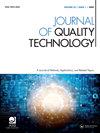Efficient analysis of split-plot experimental designs using model averaging
IF 2.2
2区 工程技术
Q2 ENGINEERING, INDUSTRIAL
引用次数: 0
Abstract
Abstract Split-plot experimental data are often analyzed as if the data came from a completely randomized design. As is well known, ignoring the different levels of randomization and replication can lead to serious inferential errors. However, in some experiments, including many of the ocean global change experiments that motivated this research, variation between whole-plot experimental units may be small relative to variation between subplot units. Even though a factorial analysis will often perform poorly in general, in this special case it outperforms a split-plot analysis, providing narrower confidence intervals for treatment means and differences with coverage rates close to the desired level. The performance of the proposed model-averaged analysis was compared to a classical split-plot analysis via a simulation study, and its utility demonstrated for an ocean global change experiment examining growth and condition of a juvenile mussel species. In our simulation study, model-averaged confidence intervals for whole-plot treatment means or comparisons of means were up to 40% narrower than split-plot confidence intervals while maintaining close to nominal coverage rates. In our example experiment, we observed narrowing of up to 25%. We recommend model averaging as a preferred approach when variation between whole-plot experimental units is expected to be less than between subplot units, with a few caveats for studies with very few replicates.用模型平均法对分裂图实验设计进行有效分析
拆分图实验数据通常被当作完全随机设计的数据来分析。众所周知,忽略不同程度的随机化和复制会导致严重的推论错误。然而,在一些实验中,包括许多推动本研究的海洋全球变化实验,整体实验单元之间的差异可能相对于子单元之间的差异较小。尽管析因分析通常表现不佳,但在这种特殊情况下,它优于分裂图分析,为治疗手段和覆盖率接近所需水平的差异提供了更窄的置信区间。通过模拟研究,将所提出的模型平均分析的性能与经典的分裂图分析进行了比较,并在研究幼年贻贝物种生长和状况的海洋全球变化实验中证明了其实用性。在我们的模拟研究中,整体图处理均值或均值比较的模型平均置信区间比分割图置信区间窄40%,同时保持接近名义覆盖率。在我们的示例实验中,我们观察到的变窄高达25%。当整块实验单元之间的差异小于子块单元之间的差异时,我们推荐模型平均作为首选方法,对于重复很少的研究有一些注意事项。
本文章由计算机程序翻译,如有差异,请以英文原文为准。
求助全文
约1分钟内获得全文
求助全文
来源期刊

Journal of Quality Technology
管理科学-工程:工业
CiteScore
5.20
自引率
4.00%
发文量
23
审稿时长
>12 weeks
期刊介绍:
The objective of Journal of Quality Technology is to contribute to the technical advancement of the field of quality technology by publishing papers that emphasize the practical applicability of new techniques, instructive examples of the operation of existing techniques and results of historical researches. Expository, review, and tutorial papers are also acceptable if they are written in a style suitable for practicing engineers.
Sample our Mathematics & Statistics journals, sign in here to start your FREE access for 14 days
 求助内容:
求助内容: 应助结果提醒方式:
应助结果提醒方式:


